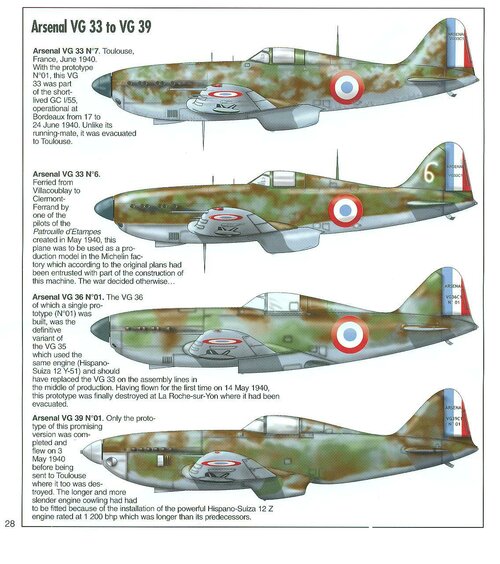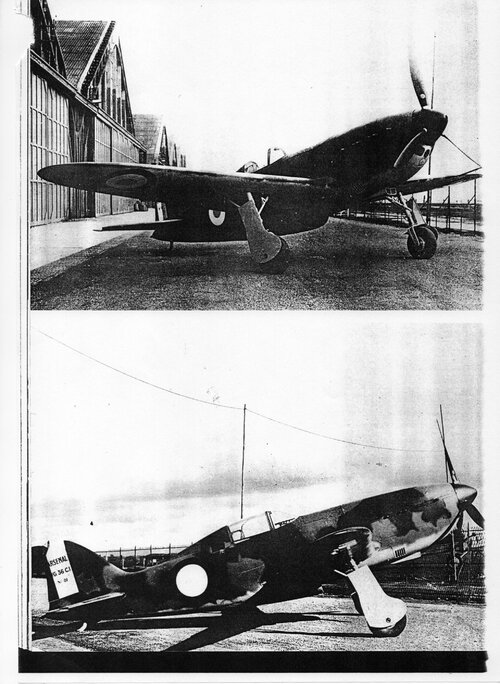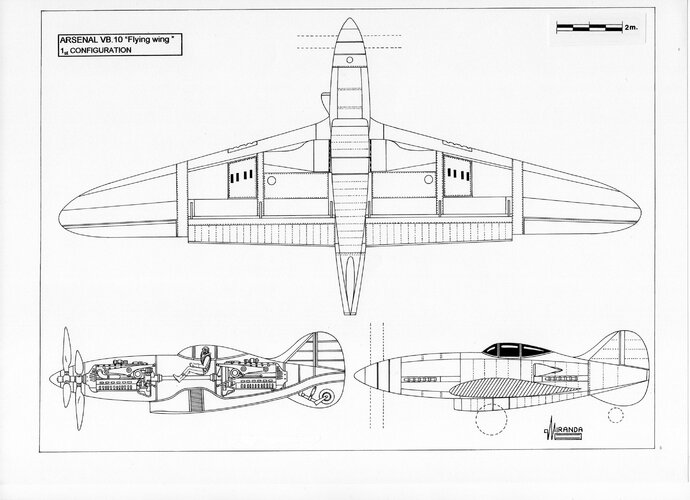Some additional info here
You are using an out of date browser. It may not display this or other websites correctly.
You should upgrade or use an alternative browser.
You should upgrade or use an alternative browser.
Arsenal de l'aéronautique ("Arsenal") projects
- Thread starter Justo Miranda
- Start date
The Arsenal VG 30 was designed as a light fighter to fulfil the Chasseur Monoplace C.1 (3 June 1937) specification that called for a small fighter propelled by one 690 hp Hispano-Suiza H.S.12 X crs engine and armed with one 20 mm H.S.9 cannon and two 7.5 mm MAC 34A drum-feed machine guns, from the obsolete Dewoitine D.510 fighters. Anticipating the possibility of a long attrition war, the VG 30 was built in wood/plywood, not to compete with the conventional fighters in the use of strategic materials. It could be manufactured in the third part of the time than an M.S. 406 for 630,000 F, a 75 per cent of the price of a Bloch M.B.152.
On October 1938, the VG 30-01 prototype reached a maximum speed that was 30 kph higher than that of the M.S.406, propelled by a less powerful 180 hp engine. It was estimated that it could fly at 560 kph with the engine of the M.S.406 and the VG 33 prototype, armed with one H.S. 404 and four MAC 34 M39, was built with that purpose.
Fifteen days after the declaration of war on Germany the S.N.C.A. du Nord received a commission for the manufacture of 220 units of the VG 33, later expanded to 500. Deliveries to l’Armée de l’Air should start at the beginning of 1940. But there were problems with the import of spruce from Canada and Romania and only seven planes entered combat between 18 and 25 June 1940, carrying out 36 missions with the GC I/55. The VG 33 outperformed the Bf 109 E-1 in manoeuvrability and fire power and was almost as fast with a less powerful 240 hp engine.
On 20 January 1940, the VG 34-01 prototype reached 590 kph, powered by one H.S.12 Y-45.
In February the VG 35-01 flew powered by a 1,100 hp H.S.12 Y-51 engine and the decision was taken to start the production of the VG 32, propelled by the American engine Allison V-1710 C-15, but only a prototype was eventually built before the German attack. In May, the VG 36-01 flew with a 1,100 hp H.S.12 Y-51. The VG 39-01 flew during the same month, propelled by a 1,200 hp H.S.12 Z reaching the 625 kph.
On October 1938, the VG 30-01 prototype reached a maximum speed that was 30 kph higher than that of the M.S.406, propelled by a less powerful 180 hp engine. It was estimated that it could fly at 560 kph with the engine of the M.S.406 and the VG 33 prototype, armed with one H.S. 404 and four MAC 34 M39, was built with that purpose.
Fifteen days after the declaration of war on Germany the S.N.C.A. du Nord received a commission for the manufacture of 220 units of the VG 33, later expanded to 500. Deliveries to l’Armée de l’Air should start at the beginning of 1940. But there were problems with the import of spruce from Canada and Romania and only seven planes entered combat between 18 and 25 June 1940, carrying out 36 missions with the GC I/55. The VG 33 outperformed the Bf 109 E-1 in manoeuvrability and fire power and was almost as fast with a less powerful 240 hp engine.
On 20 January 1940, the VG 34-01 prototype reached 590 kph, powered by one H.S.12 Y-45.
In February the VG 35-01 flew powered by a 1,100 hp H.S.12 Y-51 engine and the decision was taken to start the production of the VG 32, propelled by the American engine Allison V-1710 C-15, but only a prototype was eventually built before the German attack. In May, the VG 36-01 flew with a 1,100 hp H.S.12 Y-51. The VG 39-01 flew during the same month, propelled by a 1,200 hp H.S.12 Z reaching the 625 kph.
Attachments
-
 Arsenal 001.jpg270.6 KB · Views: 27
Arsenal 001.jpg270.6 KB · Views: 27 -
 Arsenal 002.jpg151.5 KB · Views: 20
Arsenal 002.jpg151.5 KB · Views: 20 -
 Arsenal 003.jpg176.3 KB · Views: 19
Arsenal 003.jpg176.3 KB · Views: 19 -
 Arsenal 006.jpg153.4 KB · Views: 20
Arsenal 006.jpg153.4 KB · Views: 20 -
 Arsenal 007.jpg164.9 KB · Views: 20
Arsenal 007.jpg164.9 KB · Views: 20 -
 Arsenal 009.jpg214.3 KB · Views: 22
Arsenal 009.jpg214.3 KB · Views: 22 -
 Arsenal 010.jpg199.6 KB · Views: 18
Arsenal 010.jpg199.6 KB · Views: 18 -
 Arsenal 012.jpg167.4 KB · Views: 17
Arsenal 012.jpg167.4 KB · Views: 17 -
 Arsenal 017.jpg88.4 KB · Views: 17
Arsenal 017.jpg88.4 KB · Views: 17 -
 Arsenal 018.jpg158 KB · Views: 20
Arsenal 018.jpg158 KB · Views: 20
Post-2
Attachments
-
 Arsenal 019.jpg243.4 KB · Views: 26
Arsenal 019.jpg243.4 KB · Views: 26 -
 Arsenal 020.jpg387.4 KB · Views: 23
Arsenal 020.jpg387.4 KB · Views: 23 -
 Arsenal 021.jpg28.6 KB · Views: 18
Arsenal 021.jpg28.6 KB · Views: 18 -
 Arsenal 022.jpg100.6 KB · Views: 20
Arsenal 022.jpg100.6 KB · Views: 20 -
 Arsenal 024.jpg296 KB · Views: 20
Arsenal 024.jpg296 KB · Views: 20 -
 Arsenal 026.jpg92.1 KB · Views: 21
Arsenal 026.jpg92.1 KB · Views: 21 -
 Arsenal 027.jpg90.1 KB · Views: 17
Arsenal 027.jpg90.1 KB · Views: 17 -
 Arsenal 028.jpg23.2 KB · Views: 16
Arsenal 028.jpg23.2 KB · Views: 16 -
 Arsenal 029.jpg79.2 KB · Views: 17
Arsenal 029.jpg79.2 KB · Views: 17 -
 Arsenal.jpg21.9 KB · Views: 27
Arsenal.jpg21.9 KB · Views: 27
Similar threads
-
Arsenal de l'Aéronautique ("Arsenal") designations
- Started by Apophenia
- Replies: 26
-
Postwar Arsenal de l'aéronautique ("Arsenal") projects
- Started by Jemiba
- Replies: 78
-
Arsenal de l'aéronautique: built prototypes and unbuilt projects
- Started by Jemiba
- Replies: 96
-
-








































